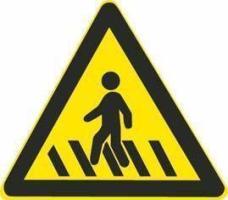1、What is the meaning of this sign?

A、Slippery section
B、Sharp curve
C、Inverse curve
D、Continuous curves
Answer:C
2、Under such circumstances, the driver should stop the vehicle and yield to pedestrians.

A、Right
B、Wrong
Answer:A
3、When such circumstances happen suddenly, drivers should reduce speed in a timely fashion or stop to yield.

A、Right
B、Wrong
Answer:A
4、What is the meaning of this sign?

A、Accident-prone section
B、Construction section
C、Reducing speed and going slowly section
D、Jammed section
Answer:A
5、What is the meaning of this sign?

A、Exit and entry for disabled people
B、Watch for disabled people
C、Rest area for disabled people
D、Special passage for disabled people
Answer:B
6、When driving on a snowy day, drivers should follow the tracks on the road before them.
A、Right
B、Wrong
Answer:A
7、What is the meaning of this sign?

A、Driving at reduced speed in the section of 40 meters
B、Minimum speed is 40km/hr
C、Maximum speed is 40km/hr
D、40km/hr speed limit ban is lifted
Answer:D
8、What should the driver pay attention to when the motor vehicle passes a school?
A、Observe the traffic signs and markings
B、Slow down and pass slowly
C、Prohibited from sounding the horn
D、Pass rapidly
Answer:ABC
9、What is the meaning of this sign?

A、Speed up when the driver can not see the pedestrians
B、Speed up
C、There is a crosswalk ahead.
D、Keep driving at the same speed when you can not see the pedestrians
Answer:C
10、The traffic police may detain the motorcycle if its driver has falsified the license plate and vehicle license.
A、Right
B、Wrong
Answer:A
11、What needs attention when a motor vehicle drives on a road covered with ice and snow?
A、Braking length is extended
B、Anti-skating resistance will be greater
C、The adhesive force of the road will be greater
D、The braking length will be shorter
Answer:A
12、What is the meaning of this sign?

A、Bump road
B、Low-lying road
C、High outburst road
D、Hump bridge
Answer:B
13、What is the meaning of this sign?

A、Continuous down slopes
B、Steep downhill road
C、Steep uphill road
D、Continuous up slopes
Answer:A
14、Which of the following acts are prohibited when passing through a tunnel?
A、Overtaking
B、Stopping
C、Making a U-turn
D、Reversing
Answer:ABCD
15、When encountering dangerous and complicated circumstance, the driver should keep medium or low speed and keep the balance of the motorcycle to pass it cautiously.
A、Right
B、Wrong
Answer:A
16、When passing through a tunnel, the wrong measure is to ___________.
A、Keep safe distance when two vehicles cross each other
B、Driving with the low beam light
C、Use the hight beam light when two vehicles cross each other
D、Overtaking in the tunnel
Answer:CD
17、When driving into the traffic flow on a main road from a relief road, drivers should speed up.
A、Right
B、Wrong
Answer:B
18、What is the meaning of this sign?

A、Road narrows on both sides
B、Road narrows on the right side
C、Road narrows on the left side
D、Bridge narrows
Answer:C
19、When there is bleeding at the bone fracture of a wounded person, the first thing to do is to keep it in position before stopping the bleeding and dress the wound.
A、Right
B、Wrong
Answer:B
20、Which of the following is an inflammable solid material?
A、Matches
B、Fireworks
C、Calcium carbide
D、Explosives
Answer:A
21、What is the meaning of this sign?

A、Overtaking ban is lifted
B、Changing lane is allowed
C、Changing lane ban is lifted
D、Borrowing lane ban is lifted
Answer:A
22、When a motor vehicle passes over an inundated road drivers should change to a high gear and pass rapidly.
A、Right
B、Wrong
Answer:B
23、What is the meaning of this sign?

A、The lane for non-motorized vehicles
B、Yield non-motorized vehicles
C、No passing for non-motorized vehicles
D、Watch for non-motorized vehicles
Answer:D
24、What should be done by motor vehicle drivers in order to yield politely to such pedestrians?

A、Speed up and bypass in front of the pedestrians
B、Speed up and bypass from behind the pedestrians
C、Reduce speed or stop to yield
D、Continuously sound the horn to alert the pedestrians
Answer:C
25、At the scene of a traffic accident, once there is a leakage of toxic and harmful substances, people must be evacuated at the first time and alarmed immediately.
A、Right
B、Wrong
Answer:A